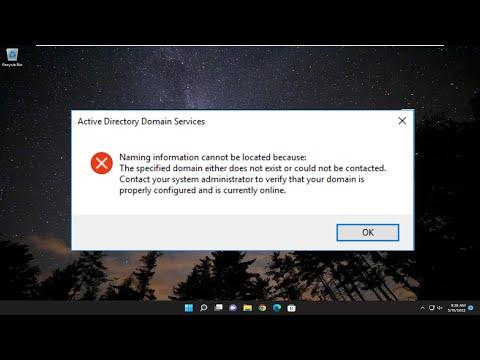I was working on a project where I needed to access a specific domain to complete some crucial tasks. Everything was going smoothly until I encountered a perplexing error message: “The Specified Domain Either Does Not Exist Or Could Not Be Contacted.” This issue struck me out of the blue and disrupted my workflow. At first, I thought it might be a temporary glitch, but as the problem persisted, I realized I had to dig deeper to find a solution.
My first step in addressing this problem was to understand what might be causing the issue. I knew that this error generally occurs when the system cannot locate or connect to the specified domain. This could be due to various reasons such as network issues, incorrect domain names, or problems with the domain controller itself. I began by checking the basics to ensure that everything was configured correctly.
The first thing I did was verify the domain name. I double-checked the spelling and format to ensure there were no typos or errors. Sometimes, a simple mistake in the domain name can lead to such problems. After confirming that the domain name was correct, I moved on to check the network connectivity. I ran a series of tests to ensure that my network connection was stable and that I could access other resources without any issues.
To delve deeper into the problem, I used the ping command to test if the domain was reachable from my machine. I also used nslookup to see if my DNS settings were correct and if the domain could be resolved to an IP address. These tools helped me identify whether the problem was related to DNS resolution or connectivity issues.
I found that while the domain could not be resolved, my network connection was stable. This led me to suspect that there might be an issue with the domain controller. I checked if the domain controller was online and functioning properly. Sometimes, if the domain controller is down or experiencing issues, it can lead to the error message I was encountering.
Another possible cause of the issue was the configuration of the DNS settings on my system. I reviewed my DNS server settings to ensure they were correctly configured. I tried changing the DNS server to a public DNS service like Google’s (8.8.8.8 and 8.8.4.4) to see if that would resolve the issue. This step helped me determine whether the problem was related to my DNS server or not.
I also examined the event logs on my machine and the domain controller to identify any errors or warnings that could provide clues about the issue. The logs often contain valuable information that can help in diagnosing problems with domain connectivity.
During my troubleshooting, I discovered that there was an issue with the time synchronization between my machine and the domain controller. Time discrepancies can sometimes cause authentication issues, leading to errors like the one I was facing. I corrected the time settings and ensured that both my machine and the domain controller were synchronized with a reliable time source.
I reviewed the network configuration, including firewall settings and security policies, to ensure that nothing was blocking the connection to the domain controller. Sometimes, security software or firewall settings can inadvertently block necessary network traffic, causing connectivity issues.
After making these adjustments, I restarted my machine and attempted to reconnect to the domain. Fortunately, the issue was resolved, and I was able to access the domain without any further problems. The ultimate solution involved a combination of verifying domain names, checking network connectivity, reviewing DNS settings, and addressing any time synchronization issues.
This experience taught me the importance of thorough troubleshooting when faced with domain connectivity issues. By methodically checking each potential cause and making the necessary adjustments, I was able to resolve the problem and continue with my project. In the future, I’ll be better prepared to handle similar issues more efficiently.
In summary, the issue of “The Specified Domain Either Does Not Exist Or Could Not Be Contacted” can stem from various sources, including domain name errors, network issues, DNS configuration problems, and domain controller issues. By carefully addressing each of these areas, I was able to fix the problem and get back on track. This experience underscored the value of a systematic approach to problem-solving and the importance of understanding the various factors that can affect domain connectivity.
